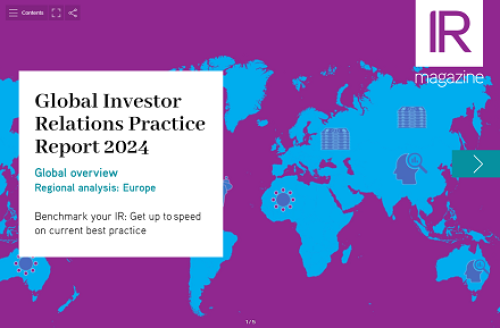When Pamela Keck, vice president of investor relations and corporate communications at German biotech Medigene, took up her role on February 1 this year, there was plenty to do. Her position had been unfilled for a number of months and executives were eager for her to hit the ground running. ‘There was no honeymoon period,’ she jokes to IR Magazine.
Thankfully, it wasn’t the first time Keck had arrived in a new IR role – far from it, in fact. Over the last 15 years, she has set up or taken over IR departments at several listed companies, both in Europe and North America. While every challenge has been unique, she says the first 100 days are always crucial. ‘You know what? It sets the tone,’ she explains.
Naturally, the first 100 days in any role are vital. It’s the time when you make first impressions, give a taste of your capabilities and are under the most scrutiny. US presidents, famously, are judged on their first 100 days. That tradition dates from 1933, when Franklin D Roosevelt, newly installed as commander-in-chief, conducted a rapid blitz of 77 new laws in a bid to revive the economy.

But the first 100 days don’t have to be a whirlwind of activity. It will depend on the specific circumstances of the organization. In fact, experienced leaders often caution against trying to do too much before you have your feet properly parked under the table.
‘Your immediate thought is that the first 100 days are the most important you’re going to have,’ says Hunter Blankenbaker, vice president of IR at Barnes & Noble Education and a 20-year IR veteran.
‘But those first 100 days are when you’re getting to know your teams – management, financial planning & analysis (FP&A), accounting, communications and legal – and are really ingraining yourself in the culture of the company. And you’re starting to build that plan for the next year or two, which I think is incrementally more important.’
Different scenarios
Your focus at the start of a new job will depend on the company’s situation. If you are setting up an IR department, it will involve creating new processes and teaching others about the demands of stock-market life.
If you’re succeeding another IRO, it’s more a question of taking inventory and thinking about how to amend the existing program. In today’s market environment, it’s more likely to be the latter, points out Alex Jorgensen, managing director and head of IR at Prosek Partners, a consultancy.
‘The first 100 days are going to be different for everyone, not just because of the industry you’re in, but because of the market conditions,’ he explains.

‘If we were talking in 2021, it most likely would be a fresh IPO or special purpose acquisition company combination. But the environment we’re in, where the IPO market has in effect been shut down for a year, means your first 100 days are probably with a company that has been public for a long time, or at least for a time prior to you joining.’
Of course, a lot of preparation happens before day one. Blankenbaker, whose previous IR roles were at Justworks, Vonage, Verizon, Terremark (later acquired by Verizon) and TOUSA, says you should already be well prepped from the interview process.
‘You’ve done a good assessment of the competitive environment, you’ve read through all the Qs and Ks and got acquainted with the model,’ he says. ‘Sometimes I’ve even built my own model of the company. You have this view you’ve built up during the whole process. And then day one is when you come in and start to stress-test some of your thoughts about how you can change things.’
Keck, who has experience working in IR and communications across biotech, IT and mining companies, says she likes to feel prepared before arriving. ‘If it’s already a public company, you have a lot of information and reading material on your hands, so you should get a pretty good idea of what the company is about and how IR has been done previously,’ she notes.
To help her get ahead, Keck was granted email access to Medigene prior to her first day, under a confidential disclosure agreement, although she says this is a rare occurrence. ‘I could be a fly on the wall for a lot of topics, which is important in my position,’ she says. ‘That’s also why the honeymoon period went out the door. The second I arrived, people said, You know what’s happening – let’s get some stuff done.’
Setting goals
With most IR hires arriving at already listed firms, Jorgensen says there are two areas he would prioritize: first, assess what objectives you have related to your internal and external stakeholders; second, establish buy-in from the C-suite. ‘If you do those two things, believe it or not, you’re going to have a difficult time failing,’ he says.
‘I see a lot of people struggle when they spend the first 100 days doing the first of those two things and not the second. Then you’ve created the best plan – potentially a better plan than anyone in that firm could have dreamt up. But if you don’t have buy-in from the C suite, that plan is going nowhere.’
Getting buy-in is often a multi-step process, adds Jorgensen. ‘If you’re an IRO, the likelihood is very high that you sit within the finance function,’ he says. ‘You need to go and achieve buy-in, possibly, with the treasurer and FP&A and then your CFO. And then once you have all that, you can go to the CEO and express your vision.’
All new starters are advised to spend time getting to know their colleagues, building relationships and asking lots of questions. For IROs who rely on their relationships to stay informed and do their job well, however, these actions are absolutely critical, say IR professionals and consultants.
‘A position like this really only lives and works with relationships, external and especially internal,’ Keck says. ‘You need to be the hub of information and be able to sort through and filter it. Build relationships so people come to you and provide you with information.’

Blankenbaker says he keeps a record of all the questions that pop into his head during the first two months, so he can follow up on them later. ‘You have to check your ego at the door as a new part of the company, because you’re going to have to ask the questions that probably feel really dumb,’ he says.
He also suggests getting out in the field and learning about the company first hand: ‘At Barnes and Noble, I’ve had the good experience of visiting three different bookstores on college campuses and really bringing that to life. It’s really important to do that.’
Jorgensen advises making the most of this initial period to ask all the basic questions. ‘If you miss out on your chance to ask questions for the first time, as a new person, I think you’ve just lost a gigantic opportunity for yourself as a new employee in any organization,’ he explains. ‘If on day 200 you’re only just getting around to asking questions about certain things, you’ll have lost credibility internally – because people will be thinking, Where have you been?’
Taking inventory
Another key early task, particularly for IROs taking over from a predecessor, is to take inventory of the existing IR program and consider what you might want to change. This might feel like a daunting task, given how many different areas there are to review.
‘I would create buckets, because the buckets will be the same in every industry,’ Jorgensen says. ‘If you’re a public company, those buckets are investor engagement, earnings and one-time strategic events, which will include your annual meeting. Everything maps to those three. Your ESG strategy, for example, should map to those one-time strategic events. You’re either building up to an annual ESG report or an ESG disclosure in certain annual SEC filings.
‘That’s not to say it’s not complex. The dichotomy beneath those buckets is fragmented and vast. But you can organize everything you need within those three areas.’

Keck recommends IROs check for an existing IR plan and, crucially, whether it matches the corporate strategy. ‘If there’s no IR strategy – or if it’s written on paper, but no one cares for it – establish one,’ she says. ‘If there’s an established strategy, great – take a look and ask some questions. Is it aligned with the corporate strategy? Is execution following the plan? What can be done to improve the feedback loop?’
As she begins to check in with external stakeholders – usually an email followed by an introductory video call – Keck also reviews the effectiveness of the corporate message. ‘Does the story resonate?’ she asks. ‘Or do I need to make amendments, perhaps to the corporate deck or even the message itself? Maybe we think our messaging is crystal clear. But in reality it might not be to an external person.’
In addition, Keck is looking for quick wins. ‘Look at what’s already established and think about where the gaps are,’ she suggests. ‘Then ask yourself what easy changes you can make right away. That way you’ll have some quick wins for yourself, and the rest of the team can see you’re a person who gets things done.’
Major change
Quick wins can help to showcase your proactive attitude. But what about bigger changes, such as rethinking the earnings process or introducing new disclosures? Your initial 100 days are the time to explore internally whether your big ideas make sense at your new company, advise IR practitioners.
Blankenbaker, who has worked at a number of companies going through strategic transformations, gives the example of wanting to disclose more on the gross margin of a particular product. ‘When you get inside a company, you start to understand some of the dynamics you didn’t fully appreciate as an outsider,’ he explains.
‘You may find you can’t provide the disclosure you were hoping to. Particularly as you go through transformations, however, disclosures are probably going to be one of your best areas of high return you can have with investors. Often, companies have legacy disclosures that are no longer meaningful. And you have to figure out: how can I work with my accounting and FP&A teams to start to think about new disclosures?’
Keck agrees that major change should not be rushed, but says you can move more swiftly if you are well versed in the sector. ‘If you know there are certain KPIs every investor looks at in that sector, and those are missing at your new company, you can probably go about it a little faster,’ she says.
Newly installed IROs should also remember that everyone, including senior management, is used to doing things a certain way, says Jorgensen. ‘Even if you dislike the established earnings process, you should do it the way it has been done to begin with,’ he says. ‘It’s important to show some respect and humility before deciding to turn it on its head.’
It’s common to review the first 100 days. In reality, especially for an IRO, you don’t have anywhere near that much time to set yourself up. The next results announcement is never very far away, especially for US companies with their quarterly earnings cycle. Conferences, roadshows and other events will also eat up those valuable initial weeks and months.
As a result, IR professionals should prioritize carefully how they spend their time at a new company. ‘The list of things you need to do in your first 100 days is infinite,’ says Jorgensen. ‘It spans from tactical to strategic. Focus on your stakeholder objectives and getting buy-in. If you do those two, you set yourself up to execute.’
This article originally appeared in the summer issue of IR Magazine










